.
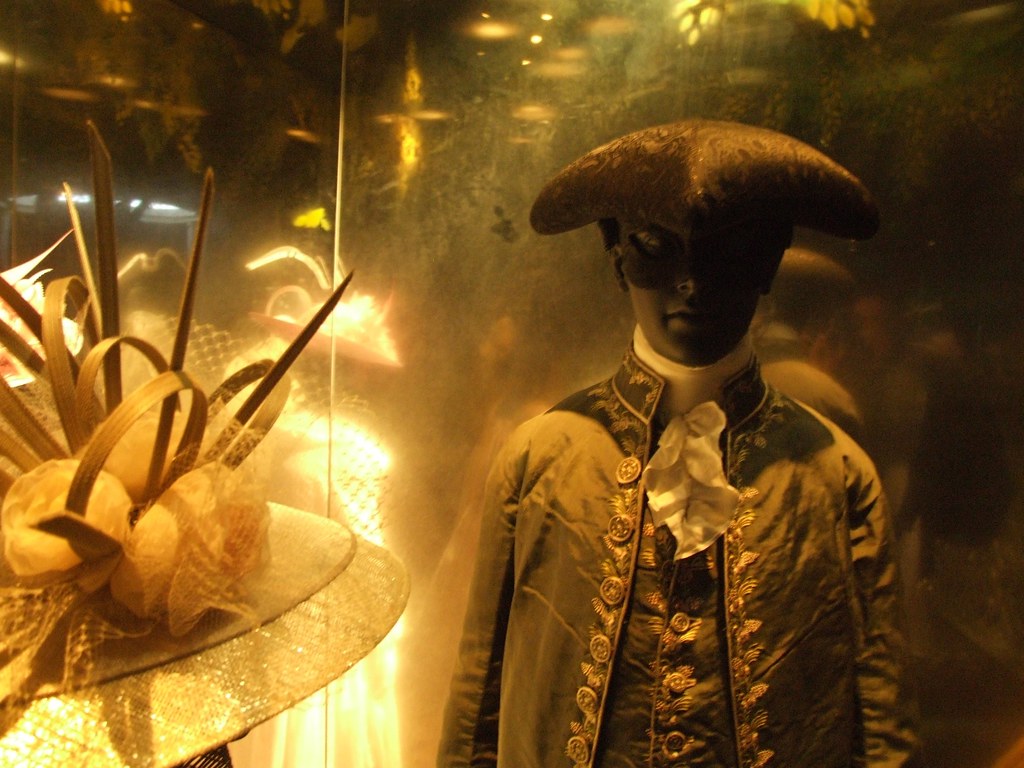
Costume from the Vauxhall Pleasure Gardens. A section of the Museum of London re-creating the Vauxhall Pleasure Gardens (before they slipped into disrepute): photo by B (falling_angel), 11 March 2011 (Museum of London)
.....“The English Garden.” -- Mason
The cold transparent ham is on my fork --
It hardly rains -- and hark the bell!-- ding-dingle --
Away! Three thousand feet at gravel work,
Mocking a Vauxhall shower! -- Married and Single
Crush -- rush; -- Soak’d Silks with wet white Satin mingle.
Hengler! Madame! round whom all bright sparks lurk
Calls audibly on Mr. and Mrs. Pringle
To study the Sublime, &c. -- (vide Burke)
All Noses are upturn’d! -- Whish-ish! -- On high
The rocket rushes -- trail -- just steals in sight --
Then droops and melts in bubbles of blue light --
And Darkness reigns -- Then balls flare up and die --
Wheels whiz -- smack crackers -- serpents twist -- and then
Back to the cold transparent ham again!
Thomas Hood (1799-1845): Sonnet to Vauxhall, 1839

Entrance to Vauxhall Gardens: Thomas Rowlandson (1756-1827) , water colour, 9 x 12 ins. (from H M. Cundall: Masters of Water-Colour Painting)
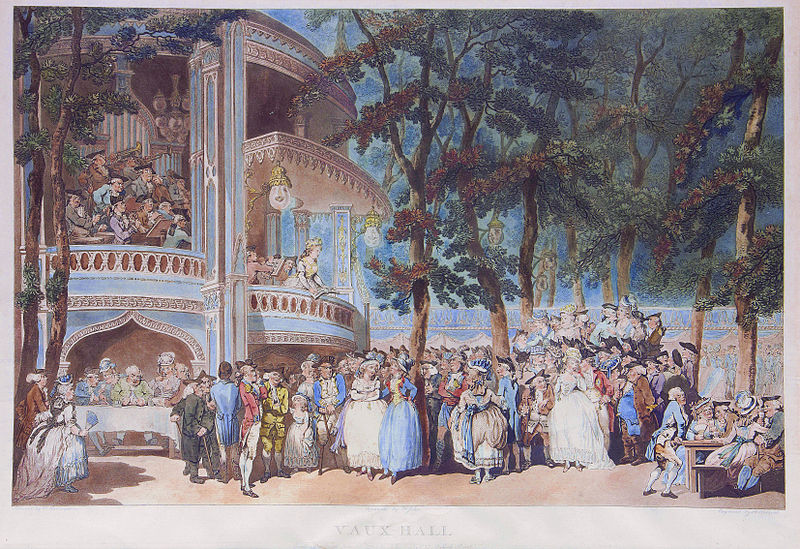
Vaux-Hall: Thomas Rowlandson (1756-1827), 20 June 1785, handcoloured etching with aquatint, on laid, 47.5 x 74.5 mm; aquatint by Francis Jukes (1745-1812); engraving by Robert Pollard (1755-1838) (Library of Congress)

Vauxhall Garden: aquatint, after a design by Thomas Rowlandson (1756–1827) and Augustus Charles Pugin (1762–1832) (after); engraving by John Bluck (fl. 1791–1819), Joseph Constantine Stadler (fl. 1780–1812), Thomas Sutherland (1785–1838), J. Hill, and Harraden (aquatint engravers) (from Rudolf Ackermann's Microcosm of London, 1809)

Tom, Jerry and Logic making the most of an Evening at Vauxhall: aquatint by George Cruikshank (1792-1878), in Robert and George Cruikshank: Life in London; or, the Day and Night Scenes of Jerry Hawthorn, Esq., and his Elegant Friend Corinthian Tom, Accompanied by Bob Logic, the Oxonian, in their Rambles and Sprees through the Metropolis (London, 1820-21) (Ohio State University Rare Books and Manuscripts Library)

Dr Syntax at Vauxhall Gardens: after Thomas Rowlandson, engraving, 1817 (private collection/The Foundling Museum, London)
...with my wife and the two maids, and the boy, took boat and to
Foxhall, where I had not been a great while. To the Old Spring Garden,
and there walked long, and the wenches gathered pinks. Here we staid,
and seeing that we could not have anything to eat, but very dear, and
with long stay, we went forth again without any notice taken of us,
and so we might have done if we had had anything. Thence to the New
one, where I never was before, which much exceeds the other; and here
we also walked, and the boy crept through the hedge and gathered
abundance of roses, and, after a long walk, passed out of doors as we
did in the other place, and here we had cakes and powdered beef and
ale, and so home again by water with much pleasure.
Samuel Pepys: diary entry for 29 May 1662
The chief part of the company having seated themselves in the
arbours, five hundred separate suppers are served in an instant ...
the price of a bottle of French claret is 5s., of one cold chicken
2s.6d., a quart of cyder 1s., a quart of small beer 4d. a slice of
bread 2d. of cheese 4d., and everything else in proportion, which
raises an elegant collation to a high rate.
The Scots Magazine, September 1739
The diversions of the times are not ill suited to the genius of
this incongruous monster, called the public. Give it noise, confusion,
glare, and glitter; it has no idea of elegance and propriety...
Vauxhall is a composition of baubles, overcharged with paltry
ornaments, ill conceived, and poorly executed.
Tobias Smollett: The Expedition of Humphry Clinker, 1771
Vauxhall Gardens is peculiarly adapted to the taste of the
English nation; there being a mixture of curious show, -- gay
exhibition, musick, vocal and instrumental, not too refined for the
general ear; -- for all of which only a shilling is paid; and, though
last, not least, good eating and drinking for those who choose to
purchase that regale.
James Boswell, The Life of Samuel Johnson, 1791
We paid our shilling at the gate, and then we saw for the first
time, that the entrance, if there had been any magic about it at all,
was now decidedly disenchanted, being, in fact, nothing more nor less
than a combination of very roughly-painted boards and sawdust. We
glanced at the orchestra and supper-room as we hurried past -- we just
recognised them, and that was all. We bent our steps to the
firework-ground; there, at least, we should not be disappointed. We
reached it, and stood rooted to the spot with mortification and
astonishment. That the Moorish tower -- that wooden shed with a door in
the centre, and daubs of crimson and yellow all round, like a gigantic
watch-case! That the place where night after night we had beheld the
undaunted Mr. Blackmore make his terrific ascent, surrounded by flames
of fire, and peals of artillery, and where the white garments of
Madame Somebody (we forget even her name now), who nobly devoted her
life to the manufacture of fireworks, had so often been seen
fluttering in the wind, as she called up a red, blue, or
party-coloured light to illumine her temple!
Charles Dickens: Sketches by Boz, 1836
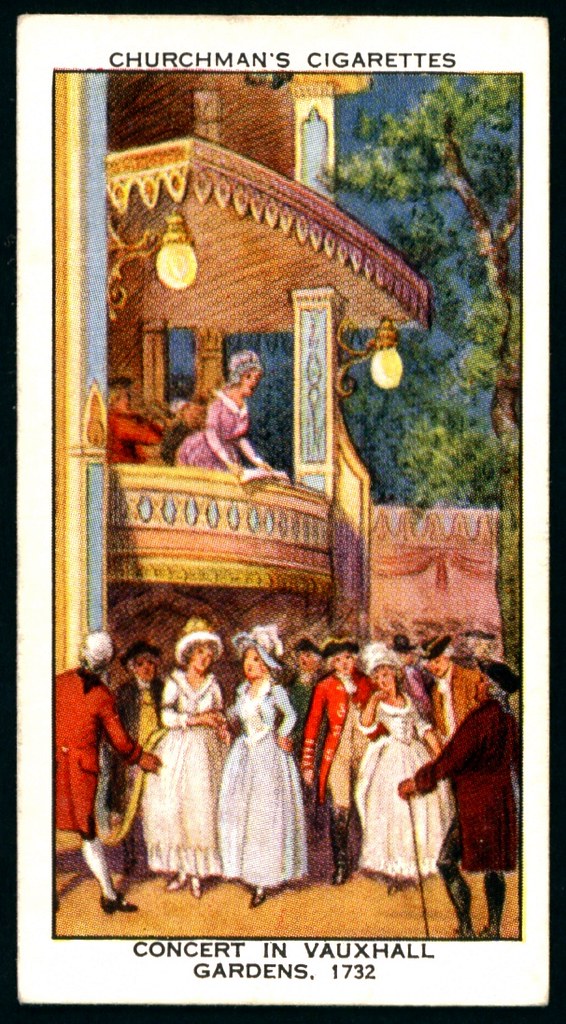
Cigarette card: Churchman's Cigarettes -- "The Story of London" (series of 50 issued in 1934): #32 Concert in Vauxhall Gardens, 1732: image by cigcardpix, 27 July 2012
Vauxhall
Gardens, across the river in Lambeth, was originally a private estate,
twelve acres of gardens opened to the public by Sir Samuel Morland in
the Restoration; Pepys went there to eat lobster and syllabub, listening
to the nightingales, the Jew's harp and the fiddles. The Vauxhall
groves had been popular ever since and the dusky walks acquired an
appropriately shady reputation which lasted until 1727 when the lease of
this 'rural brothel' was taken by the twenty-six-year-old Jonathan
Tyers. It was a bold move, to take the lease for thirty years at £250 a year, but one that proved so successful that Tyers eventually bought Vauxhall outright in the late 1750s...
In the season, from April or May until late August, the Gardens were open three times a week. Part of the charm of Vauxhall... was the trip by water. On summer evenings [visitors] might head for Westminster or Whitehall stairs, where wherries were always waiting, and glide across to join the scramble on the other bank a short way upstream... At the narrow landing stage the boats shoved and nosed their way in and there was always confusion, quarreling and swearing, but after the short walk up the lane the revellers entered a magic world.
In the season, from April or May until late August, the Gardens were open three times a week. Part of the charm of Vauxhall... was the trip by water. On summer evenings [visitors] might head for Westminster or Whitehall stairs, where wherries were always waiting, and glide across to join the scramble on the other bank a short way upstream... At the narrow landing stage the boats shoved and nosed their way in and there was always confusion, quarreling and swearing, but after the short walk up the lane the revellers entered a magic world.
Over the years Tyers
added pavilions, supper boxes, statues, porticoes and colonnades and
elaborate trompe l'oeil effects, and thousands remembered the
shock of delight as they walked through the gates and saw the hundreds of
lights glimmering through the trees. The orchestra played from seven
until nine ('new songs from Vauxhall' were always in vogue) and then
broke for supper; chicken and beef and ham of legendary thinness,
cheesecakes and tarts, strawberries and sweet custard, port for the men
and hock and sherry for the ladies. As dusk turned to dark and couples
began to wander off into the groves, flirtation began in earnest.
Vauxhall
brought down on Tyers' head exactly the sort of criticism that [had
attended the] masquerades -- accusations of sexual licence, assignations
and, worst of all, an indiscriminate mixing of class, allowing footmen
to dally with countesses and clergymen with parlourmaids. One anonymous
critic... thought this false, erotic, Arcadian blurring of levels
brought nothing but harm, simply transporting the dissolute Covent
Garden world to the other bank of the Thames:
From Drury's bounds see shining Throngs repair
With borrow'd charms to breathe in sweeter Air;
With borrow'd charms to breathe in sweeter Air;
From stinking Rags and lofty Garret free'd,
Lo! Oyster Betty shines in soft Brocade,
Lo! Oyster Betty shines in soft Brocade,
See Fops and Haggs dress out, a Glitt'ring Show!
Each Barber's Prentice makes a powder'd Beau...
Each Barber's Prentice makes a powder'd Beau...
Tyers
tried hard to oblige 'the Polite and Worthy Part of the Town, by doing
everything in his Power that may contribute to their Ease and Pleasure'
and keeping the riff-raff out, 'such as are not fit to intermix with
these Persons of Quality'. He worked to exclude prostitutes and pimps...
But, as at the masquerade, the crossing of boundaries was part of the
charm. The Vauxhall crowd on a soft June night brought all London's
worlds together...
Jenny Uglow: Hogarth, A Life and a World, 1997

A General Prospect of Vaux Hall Gardens: engraving by J.S Muller after Samuel Wale, 1751 (private collection)

The Grand Walk, Vauxhall Gardens, London: Antonio Canaletto, c. 1751 (Collection Compton Verney)

George Frederic Handel: marble statue by Louis Francois Roubiliac, commissioned for Vauxhall Gardens by Jonathon Tyers, 1738. "Handel has not dressed up to have his portrait taken. He sits comfortably in his indoor clothes, his shirt partially unbuttoned, his slippers off and dangling, and his soft cap pulled over his cropped hair. He is totally at ease with the little naked boy who writes down the music which the composer is striking on a rather fanciful lyre. The boy has propped his paper against a viol, and an oboe and flute lie discarded beside him. Handel has crossed his legs and listens attentively to his own music, while his left elbow rests on leather-bound scores of his operas and oratorios, including 'Alexander's Feast', finished in 1737, just a year before Roubiliac signed his name on the plinth of this marble statue." (Victoria and Albert Museum, London)

George Frederic Handel: marble statue by Louis Francois Roubiliac, commissioned for Vauxhall Gardens by Jonathon Tyers, 1738. "Handel has not dressed up to have his portrait taken. He sits comfortably in his indoor clothes, his shirt partially unbuttoned, his slippers off and dangling, and his soft cap pulled over his cropped hair. He is totally at ease with the little naked boy who writes down the music which the composer is striking on a rather fanciful lyre. The boy has propped his paper against a viol, and an oboe and flute lie discarded beside him. Handel has crossed his legs and listens attentively to his own music, while his left elbow rests on leather-bound scores of his operas and oratorios, including 'Alexander's Feast', finished in 1737, just a year before Roubiliac signed his name on the plinth of this marble statue." (Victoria and Albert Museum, London)
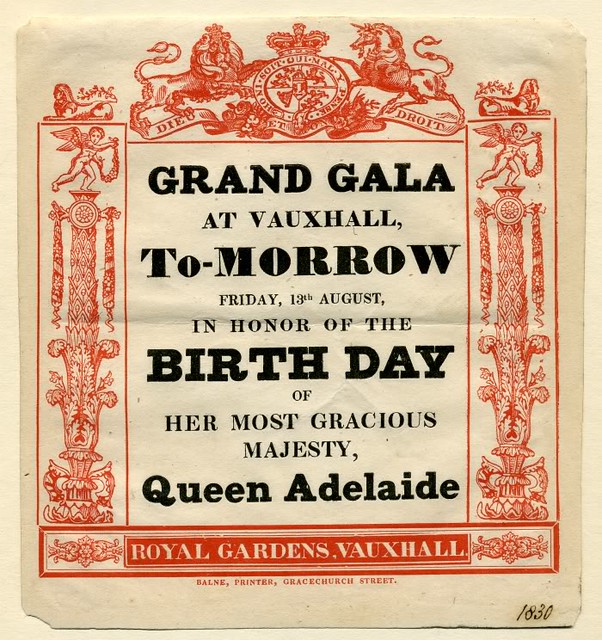
Vauxhall Gardens ephemera printing, 1830: printed by Balne and Co.; image by sos222 (Stephen Saxe), 29 October 2010
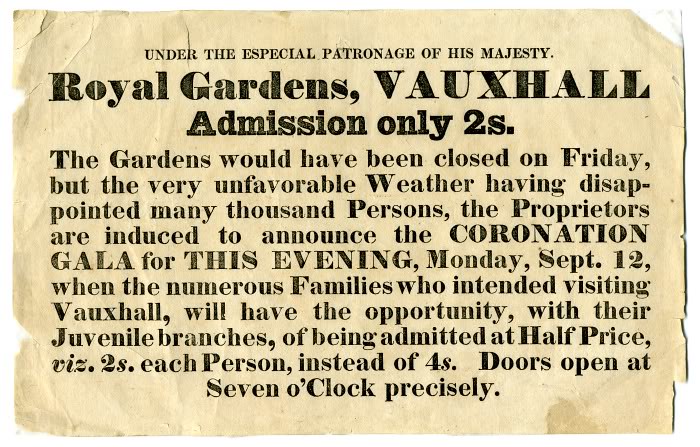
Vauxhall Gardens ephemera printing, 1831: printed by Balne and Co.: image by sos222 (Stephen Saxe), 29 October 2010

Vauxhall Gardens ephemera printing, c. 1833: printed by Balne and Co.: image by sos222 (Stephen Saxe), 29 October 2010
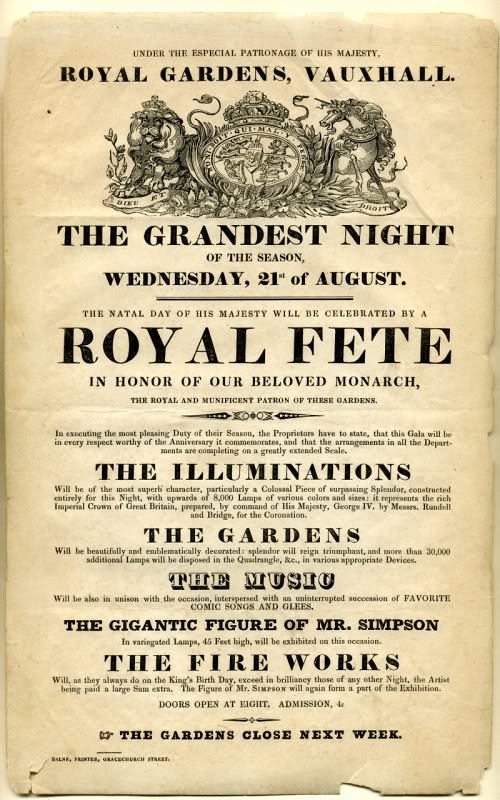
Vauxhall Gardens ephemera printing, 1833: printed by Balne and Co.: image by sos222 (Stephen Saxe), 29 October 2010

Vauxhall Gardens, London, 1817: engraver unknown; image by lili kamille (lilikk), 25 February 2010

Vauxhall Pleasure Gardens: Ascent of the Vauxhall Balloon and Mr. Cocking's Parachute: artist unknown, from The Mirror, Saturday 29 July, 1817; image by Dan Tassell, 21 January 2011
Poster advertising Vauxhall Gardens closing night, Monday 26 July 1859. It was dubbed the ‘Last Night For Ever’. People sang, horses performed in The Rotunda and finally, after some dancing, visitors watched a firework display entitled ‘Farewell for Ever": via Museum of London

Vauxhall Gardens ephemera printing, 1830: printed by Balne and Co.; image by sos222 (Stephen Saxe), 29 October 2010

Vauxhall Gardens ephemera printing, 1838: printed by Baine and Co .; image by sos222 (Stephen Saxe), 29 October 2010
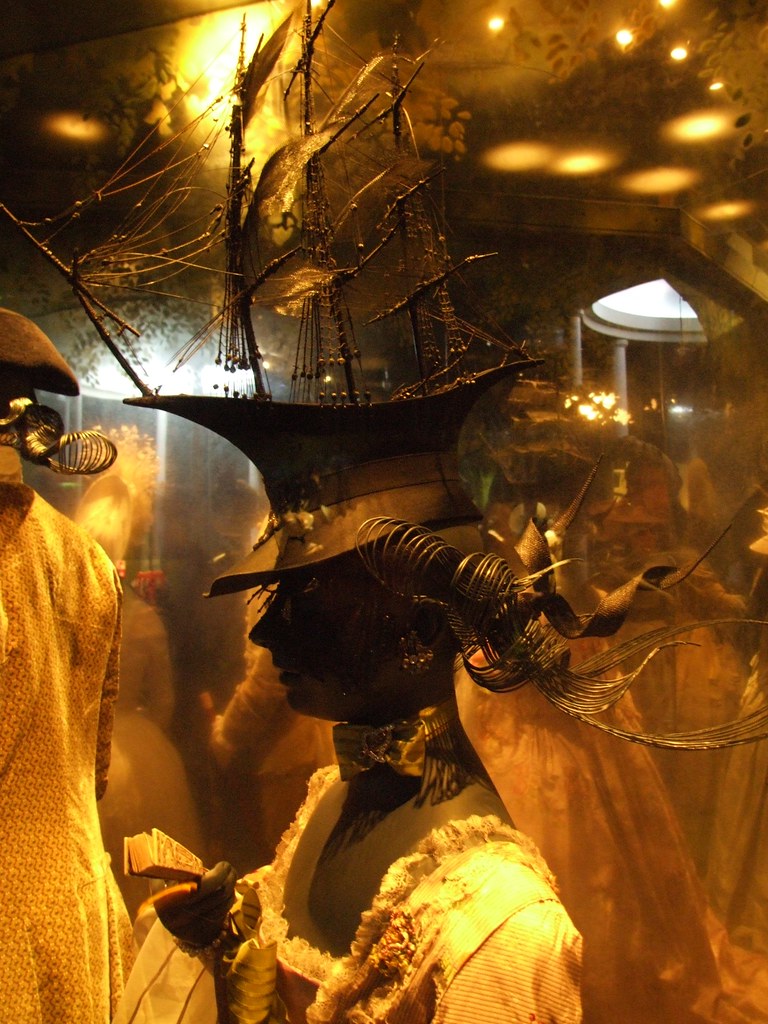
Costume from the Vauxhall Pleasure Gardens. A section of the Museum of London re-creating the Vauxhall Pleasure Gardens (before they slipped into disrepute): photo by B (falling_angel), 11 March 2011 (Museum of London)
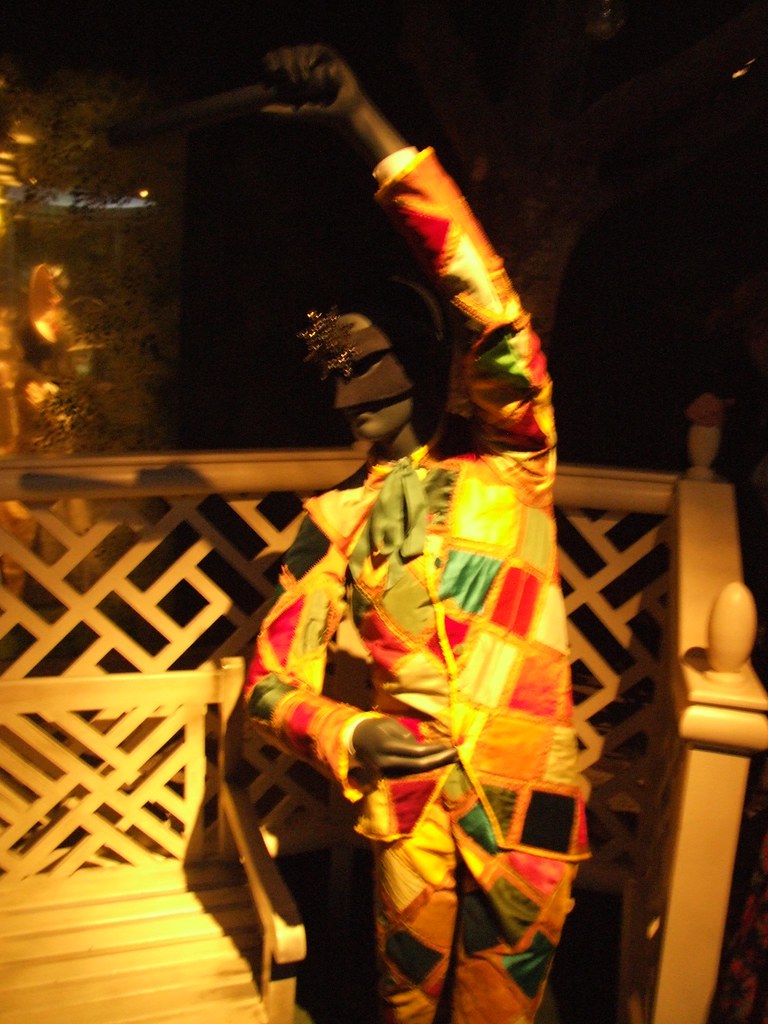
Costume from the Vauxhall Pleasure Gardens. A section of the Museum of London re-creating the Vauxhall Pleasure Gardens (before they slipped into disrepute): photo by B (falling_angel), 11 March 2011 (Museum of London)

Costume from the Vauxhall Pleasure Gardens. A section of the Museum of London re-creating the Vauxhall Pleasure Gardens (before they slipped into disrepute): photo by B (falling_angel), 11 March 2011 (Museum of London)
Costumes from the Vauxhall Pleasure Gardens. A section of the Museum of London re-creating the Vauxhall Pleasure Gardens (before they slipped into disrepute). The Vauxhall Gardens ran from the mid 17th century to the mid 19th century. The site was known as Vauxhall Gardens from 1785 with admission charged for entry into a range of entertainments. The rococo "Turkish tent" became one of the Gardens' structures, the interior of the Rotunda became one of Vauxhall's most viewed attractions, and the chinoiserie style was a feature of several buildings. The "last night" of the gardens was 5 September 1839 attracting 1089 people. It did re-open until 1859, when it closed, when was sold off for building (Museum of London)




17 comments:
"The illuminations began before we arrived, and I must confess that, upon entering the gardens, I found every sense overpaid with more than expected pleasure.”
-- Oliver Goldsmith, The Citizen of the World, 1760
So, now that we've escaped the Dead Malls... were we having fun yet?
At Vauxhall fountains of water suddenly showered unsuspecting visitors with jets of water to amuse dry onlookers! Ha ha ha!!
A remarkable marble statue of the composer Handel was made for the Gardens in 1738. The statue astonished passers-by because it showed Handel in his dressing-gown and slippers, without his wig. Only his closest friends (and of course God) would have seen him like this in real life.
In 1850, a hot-air balloon was sent up into the sky above the Gardens. Instead of a basket, a horse was secured underneath the balloon with the balloonist on its back.
The ham at Vauxhall Pleasure Gardens was famed to be cut so thinly that you could read a newspaper through it.
Rupert Murdoch are you listening?
And now?! http://www.willpearson.co.uk/high_resolution/vauxhall-bridge-view/
Just in shot to the left is this building
http://en.wikipedia.org/wiki/SIS_Building
Hood: all the vowels seem to be in contention here. A great hubbub. I love that we start and end with the meat on the fork that's hardly there.
"...we saw for the first time, that the entrance, if there had been any magic about it at all, was now decidedly disenchanted, being, in fact, nothing more nor less than a combination of very roughly-painted boards and sawdust".
Is there any way to the boards and the sawdust now?
Good of Dickens to have seen through the folly and frippery, as if by x ray vision. But we should not feel superior. "Our epoch" is a web of technological self deception we have spun, or have allowed to have spun, out of literally nothing at all. I'd take sawdust and boards any day of the week.
The great impact of the repetition (circling back around) of the brilliant shocked vision of the transparent ham is made possible by the oldest trick in the book of poetry, the awakening of the pattern-recognition centres of the brain.
Many decades ago General Motors sold one of their English-made cars, the Vauxhall, to compete with the Japanese imports just showing up in the USA. The Vauxhall never caught on—Americans were still into big cars and mucho horsepower—but after reading this I’ve got a better idea of the market that GM was aiming for—with a car that turned out to be too close in quality to the “roughly-painted boards and sawdust” of its namesake.
"Wench",
now there's a word not heard much these days nor is it likely to be making a comeback any time soon but really, all politics aside 'tis a lovely word
Yes FUN!
More than Fun!
"crossing of boundaries was part of the charm. The Vauxhall crowd on a soft June night brought all London's worlds together..."
Oh to be there again.
Please can we go again sir? Please sir don't take us back to the evil mall of mordor anytime soon sir.
What a fine work you have created, truly. It must have cost you a great deal of time and perhaps some important brain cells. Most Generous.
A heartfelt Thanks to you, Cap'n.
Yes There really wasn't much affluence in the UK post war (Rationing ended I think in 1955) and only the few could afford cars even into the 60's There were many marques that were very basic indeed
We had a mini in the 60's which often needed help from a hand-crank to get it started in the winter In the Scottish summer (?) you had to be careful it didn't overheat on longer journeys We did have a Vauxhall in the early 70's but it did have a back seat which the van version of the mini didn't have It wouldn't be allowed now but myself and my 2 brothers travelled in the back of the Morris mini van
http://images.businessweek.com/ss/0/05/0515_mini_50th_anniversary/3.htm
and kneeled or sat cross legged on cushions ... no seat belts either Mind you top speed was just over 70 going downhill so maybe we weren't in too much danger So the crappy Vauxhall was a big step up in safety and comfort for us This model-
http://www.vauxhallviva.com/?page_id=55
I'm laughing There was a GT version too
My parents put their money into their kids education and buying a home which in the 60's was not so common for working-class families
Excellent--now we know why GM's Vauxhall bit the dust.
Oh, I love those hats! When I saw the first picture I thought it might be a pickled Jeremy Bentham - but of course he was stuffed, which isn't quite so photogenic. Too bad we no longer have the Vauxhall Pleasure Gardens to play in, nor the inclination to build anything similar. I wonder what happened to the statue of Handel in his dressing gown & slippers?
Artur.
Fotos that return us to the "present" day, a day some say is a "gift," so I shall try to look upon it as such
Thanks Dalriada for the great foto of the Vauxhall Viva, a car that even a wrench-challenged hippie like myself could probably have fixed on a rainy night. We weren't producing such great vehicles in the US in the 60's either (c.f. Ralph Nader, etc.) and the GM Vauxhall probably bit the dust because still somewhat accountable thieves like Nixon and his ilk were raking in every penny from every interest, cars, dead boys and girls, fake moon shots now glorified in hi-tech movies which are part of the only Vauxhall outings that remain, if any do. Thanks too, Dalriada for the amazing foto of Vauxhall bridge which knocked this delirious, dislocted Bronx Boy back into the stupefyingly hideous present world of mechanical regimes and all that great information about and image of MI5. I didn't really want to return to this particular version of world 117.963 at all. They did "class" right back in the days covered by this post. I mean there were "classes", at least 4 of them, unlike today where there is one bloody rich class partying madly in a giant bubble -- Republicrat Clones arguing about just how much austerity will be enough to trigger a "recovery" while leaving the other 5 or 6 billion to drown in the rising seas, burst from thirst in the new deserts, bloat from the poisoned but profitable food, etc., but I digress.
Much appreciated, those links.
Tom, how I wish I had been able to attend your classes at New College.
I feel a little giddy after our group outing through space/time in Vauxhall. Up early today to prepare for a long trip into the cloud factory high in the mountains of Costa Rica where I shall offer some of the newest wave of gringo poetry to the Ticos who meet weekly at poetry workshops across the broad, high, central valley. A cold steady, at times "horizontal" rain is falling there from now until November. Extra rain everywhere these days. I am remembering now how the Idiot, responding to another question regarding those multi-trillion dollar wars said "Well, Bring it on!" OK, then, bring it on!
Saludos,
Harris
Many thanks to all you intrepid adventurers out there.
Artur,
Brilliant indeed, those hats. Mr Bentham should have done so well. But of course from a utilitarian POV, having a pillow, a frigate or a set of antlers atop one's head can't have been a particular asset. (Except perhaps to a passing bird -- and even then, perhaps more scarifying than inviting?).
Here by the by is Jeremy, pickled.
He appears to have locked himself in the WC, poor man. To stay thus pickled forever and a day.
Handel, of course, along with Hogarth, were the two great artists without whose assistance (monetary as well as artistic) Tyers would not have been able to make what he did of the Gardens.
Thanks for reminding me to hunt down Mr Handel, deshabillé.
He is now in the party, as is only just... just beneath the Canaletto.
Well, I suppose conflating pickling with stuffing is hardly fair. Conscience strikes again. Put oneself in Jeremy Bentham's shoes, and... no, cancel that thought. And it's not a WC he's in but a proper cabinet, in fact.
Certain it is that Bentham loitered uselessly, and no doubt furtively, at the Pleasure Gardens, on some occasion. One can't help wondering if the following information did not tempt the special effects staff at Vauxhall -- a curiosity too far, perhaps?
"The cabinet contains Bentham's preserved skeleton, dressed in his own clothes, and surmounted by a wax head. Bentham requested that his body be preserved in this way in his will made shortly before his death on 6 June 1832. The cabinet was moved to U[niversity] C[ollege] L[ondon] in 1850.
"Not surprisingly, this peculiar relic has given rise to numerous legends and anecdotes. One of the most commonly recounted is that the Auto-Icon regularly attends meetings of the College Council, and that it is solemnly wheeled into the Council Room to take its place among the present-day members. Its presence, it is claimed, is always recorded in the minutes with the words Jeremy Bentham -- present but not voting. Another version of the story asserts that the Auto-Icon does vote, but only on occasions when the votes of the other Council members are equally split. In these cases the Auto-Icon invariably votes for the motion. Stories of the Auto-Icon's regular attendance at Council meetings are, however, myths.
"Bentham had originally intended that his head should be part of the Auto-Icon, and for ten years before his death (so runs another story) carried around in his pocket the glass eyes which were to adorn it. Unfortunately when the time came to preserve it for posterity, the process went disastrously wrong, robbing the head of most of its facial expression, and leaving it decidedly unattractive. The wax head was therefore substituted, and for some years the real head, with its glass eyes, reposed on the floor of the Auto-Icon, between Bentham's legs. However, it proved an irresistible target for students, especially from King's College London, who stole the head in 1975 and demanded a ransom of £100 to be paid to the charity Shelter. UCL finally agreed to pay a ransom of £10 and the head was returned. On another occasion, according to legend, the head, again stolen by students, was eventually found in a luggage locker at a Scottish Station (possibly Aberdeen). The last straw (so runs yet another story) came when it was discovered in the front quadrangle being used for football practice, and the head was henceforth placed in secure storage.
"Many people have speculated as to exactly why Bentham chose to have his body preserved in this way, with explanations ranging from a practical joke at the expense of posterity to a sense of overweening self-importance. Perhaps the Auto-Icon may be more plausibly regarded as an attempt to question religious sensibilities about life and death. Yet whatever Bentham's true motives, the Auto-Icon will always be a source of fascination and debate, and will serve as a perpetual reminder of the man whose ideals inspired the institution in which it stands."
University College London Bentham Project
And here one can play about a bit with the Auto-Icon, rotating, enlarging & c.:
Jeremy Bentham Auto-Icon
That dizzying spin which Jeremy's Auto-Icon performs when the link is clicked on -- is it only me who wondered if that flexi-dummy might have inspired a certain later film?
"Bentham had intended the Auto-icon to incorporate his actual head, mummified to resemble its appearance in life. However, his [medical friend] Southwood Smith's experimental efforts at mummification, based on practices of the indigenous people of New Zealand and involving placing the head under an air pump over sulphuric acid and simply drawing off the fluids, although technically successful, left the head looking distastefully macabre, with dried and darkened skin stretched tautly over the skull. The Auto-icon was therefore given a wax head, fitted with some of Bentham's own hair. The real head was displayed in the same case as the Auto-icon for many years, but [due to that insistent collegiate pilfering, referred to above] ...is now locked away securely."
The present wax head is fully detachable and sewn-on, as in the Hollywood version.
You are welcome Harris I used to live not so far away in Kennington (where The Oval cricket ground is) All that development including the MI6 building did not exist When I moved to London in the 80's it was quite down at heel in many places When I lived in the East End the Canary wharf development had not yet begun I lived on a boat for a while and would go out rowing in the huge empty docks of a Sunday So much flashy architecture has gone up along the water front where I remember crumbling wooden wharves The last 30 years achieved the illusion of a generally prosperous city and Capital it also put conspicuous consumption centre stage in a country that once saw a degree of visible austerity as a virtue Now the whole thing is an obvious playground . . . if you have the money
Vauxhall Motors in the UK still going strong
http://media.vauxhall.co.uk/media
/gb/en/vauxhall/news.html
Their "auto icon" being a griffon
I wonder if Mr. Bentham has considered a career in the present Tory Cabinet Two heads Two faces He might do well
And speaking of 'doubles' Mr Hood seems to have been very fond of punning: "However critics may take offence,
A double meaning has double sense."
I note the Dundee connection I wonder if he ever met William MacGonagall My maternal grandmother worked in the Jute mills in Dundee when she was a youngster Born in New York .. but that's another story Apologies maybe I am at that memorialising age Fun anyway for me to be sparked off so Thanks Tom
Tom,
"Married and Single
Crush -- rush; -- Soak’d Silks with wet white Satin mingle."
O what a life it must have been, makes things seem a bit drab around here. . . .
7.17
light coming into fog against invisible
ridge, crow calling from branch in left
foreground, no sound of wave in channel
which in the following will
be called point, that
which is that, second which
may also be, first of
grey white fog above shoulder of ridge,
cormorant flapping across toward point
We are here but to spark and memorialise...
And so... a taste of the sort of tune one might have heard, there, of a summer's evening, in the supperboxes, beneath the concealing trees...
London Early Opera: Handel, Vauxhall Hornpipe, 1740 (VFW 356)
At Vauxhall, Sir Samuel Morland built a fine room, anno 1667, the inside all of looking-glass, and fountains very pleasant to behold, which is much visited by strangers: it stands in the middle of the garden, covered with Cornish slate, on the point of which he placed a punchinello, very well carved, which held a dial, but the winds have demolished it.
John Aubrey: Antiquities of Surrey
Post a Comment